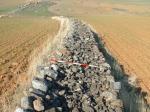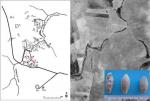Summary (English)
Research (2003-2005)
Surface surveys exposed a number of coordinated elements, extraordinarily well- adapted to the layout of nature: a) two trapezoidal walled areas, a large one and a small one; b) a series of fifteen circular redoubts or small forts in a line of three by three; c) a series of eight small redoubts for further strengthening strategic locations of the complex; d) stone walls (titula) forming a line of parallel obstacles to block the way; e) outbuildings used to shelter and protect the animals travelling with the army and f) a presumably preliminary or earlier military facility.
This complex of structures may have met the objective of an overall strategic plan. The “El Pedrosillo” military complex allowed the Romans both, defense against enemies and launching raids into enemy territory simultaneously, as this crucial position ensured close surveillance and direct control of a strategic communication hub. Therefore, this place is more than a simple military camp. It constitutes a unique example of castramentation as well as strategy, in one of the most conflict-ridden territories during the conquest of Hispania.
(translation by Laura González Fernández)
- Francisco Germán Rodríguez Martín
Director
- Francisco Germán Rodríguez Martín, Jean-Gérard Gorges, Angel Morillo Cerdán y Esperanza Martín Hernández
Team
Research Body
- Casa de Velázquez, Consejería de Cultura y Patrimonio de la Junta de Extemadura, CNRS-Université de Toulouse-le-Mirail y Universidad de León
Funding Body
- Ministerio español de Educación y Ciencia (I + D HUM2006-00534), Casa de Velázquez y Arquex, S.L.






![Download [PDF]](/excavation/skins/fasti/images/results/download_sml.png)
